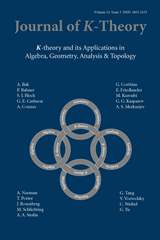Article contents
Analysis on arithmetic schemes. II
Published online by Cambridge University Press: 20 May 2010
Abstract
We construct adelic objects for rank two integral structures on arithmetic surfaces and develop measure and integration theory, as well as elements of harmonic analysis. Using the topological Milnor K2-delic and K1×K1-delic objects associated to an arithmetic surface, an adelic zeta integral is defined. Its unramified version is closely related to the square of the zeta function of the surface. For a proper regular model of an elliptic curve over a global field, a two-dimensional version of the theory of Tate and Iwasawa is derived. Using adelic analytic duality and a two-dimensional theta formula, the study of the zeta integral is reduced to the study of a boundary integral term. The work includes first applications to three fundamental properties of the zeta function: its meromorphic continuation and functional equation and a hypothesis on its mean periodicity; the location of its poles and a hypothesis on the permanence of the sign of the fourth logarithmic derivative of a boundary function; and its pole at the central point where the boundary integral explicitly relates the analytic and arithmetic ranks.
Keywords
Information
- Type
- Research Article
- Information
- Copyright
- Copyright © ISOPP 2010
References
- 12
- Cited by

